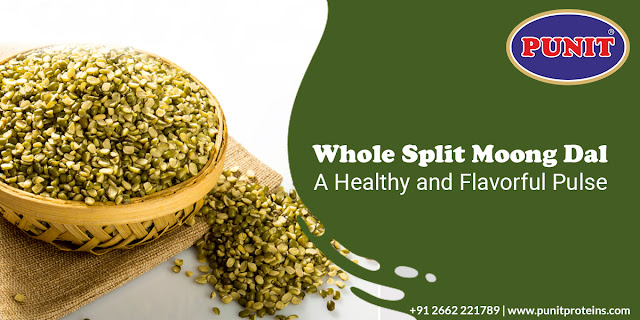Whole Split Moong Dal: A Healthy and Flavorful Pulse
What is whole split moong dal:
Whole split moong dal is a type of lentil that has been split but not skinned. It is yellow in color and has a mild, nutty flavor. It is commonly used in Indian cuisine and is a staple ingredient in many dishes such as soups, stews, and curries.
Nutritional Benefits of Whole Split Moong Dal:
●
Rich in protein: Whole split moong dal is a good source
of plant-based protein, which is essential for building and repairing tissues
in the body.
●
Low in fat: It is low in fat and contains mostly
unsaturated fats, which are good for heart health.
●
Rich in fiber: Whole split moong dal is a good source
of dietary fiber, which helps regulate digestion and promotes satiety.
●
Good source of vitamins and minerals: It contains
important vitamins such as folate, and minerals like iron, potassium, and
magnesium.
●
Low glycemic index: Whole split moong dal has a low
glycemic index, making it a good option for people with diabetes.
● May improve heart health: Its low-fat content and high fiber content can help lower cholesterol levels and reduce the risk of heart disease.
How to Cook Perfect
Whole Split Moong Dal Every Time?
·
Rinse the dal thoroughly and soak in water for
30 minutes.
·
In a pot, add the dal, water (2 cups per 1 cup
of dal), salt, and any spices you like.
·
Bring to a boil and then reduce heat to low.
·
Cook, covered, for 20-25 minutes or until the
dal is soft.
·
Mash the dal with a spoon to desired
consistency.
· Serve with rice or roti. Enjoy!
The Versatility of
Whole Split Moong Dal in Indian Cooking:
Whole Split Moong Dal is a staple ingredient in Indian cooking and is highly versatile due to its mild flavor, soft texture, and easy cookability. Some common uses include:
·
Making dal dishes, like dal makhani or dal fry.
·
Adding to soups and stews for added protein.
·
Using as a base for dips and spreads, like moong
dal hummus.
·
Making pakoras, fritters, and other snack foods.
·
Adding to rice dishes for added flavor and
nutrition.
·
Mixing with spices and flour to make dough for
rotis and other flatbreads.
· Soaking and grinding to make flour for various dishes, like dosa and vada.
Overall, Whole Split Moong Dal is a staple ingredient in Indian cuisine and can be used in a variety of dishes to add flavor, nutrition, and texture.
Discover the Magic of Whole Split Moong Dal in Your Kitchen:
Whole Split Moong Dal is a type of lentil that is highly nutritious and versatile in cooking. It has a mild flavor and soft texture, making it a popular ingredient in Indian cuisine. Here are some benefits and ways to incorporate Whole Split Moong Dal in your kitchen:
- · Nutritional benefits: It's a good source of protein, fiber, and essential vitamins and minerals.
- · Quick cooking: Whole Split Moong Dal cooks quickly, making it a convenient ingredient for busy weeknights.
- · Versatile: It can be used in a variety of dishes, including soups, stews, curries, and salads.
- · Easy to digest: Its soft texture and high fiber content make it easily digestible.
To use Whole Split Moong Dal in your kitchen, try making a simple Dal recipe by simmering the lentils with spices, such as cumin, coriander, and turmeric, until tender. Serve with rice or flatbread for a complete meal. You can also try adding it to soups, stews, and curries for a boost of protein and fiber.
From Soups to
Curries: The Many Uses of Whole Split Moong Dal:
Whole split moong dal, also known as yellow moong dal, is a versatile ingredient in Indian cuisine. It is commonly used to make soups, curries, stews, and is also used to make a popular Indian snack called dal tadka. The mild flavor and soft texture of moong dal make it a popular ingredient in many dishes. It is also a nutritious ingredient, as it is rich in protein, fiber, and iron.
Why Whole Split Moong
Dal Should be a Staple in Your Diet:
●
High in protein and fiber.
●
Low glycemic index, helps regulate blood sugar levels.
●
Rich in antioxidants and minerals such as iron,
potassium, and magnesium.
●
Gluten-free and easy to digest.
●
Versatile ingredient, can be used in a variety of
dishes.



Comments
Post a Comment